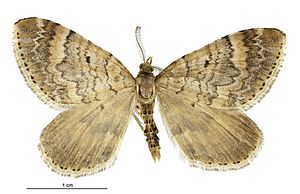Asaphodes dionysias facts for kids
Quick facts for kids Asaphodes dionysias |
|
|---|---|
 |
|
| Male | |
| Scientific classification | |
| Synonyms | |
|
Asaphodes dionysias is a special kind of moth that belongs to the Geometridae family. This moth is found only in New Zealand. It's unique because the female moths have much smaller wings compared to the males. You can only find this moth in the mountains of Central Otago.
Contents
About This Moth
How it Got its Name
This moth was first described in 1907 by a scientist named Edward Meyrick. He originally named it Xanthorhoe dionysias. He studied moths that were collected by J.H. Lewis from the Old Man Range in Central Otago.
Later, in 1987, another scientist named Robin C. Craw suggested that this moth should be placed in a different group, called the Asaphodes genus. In 1988, John S. Dugdale agreed with this idea. The original moth specimen used to describe the species is kept at the Natural History Museum, London.
What it Looks Like
Male Asaphodes dionysias moths are about 28 millimeters wide when their wings are spread. Their heads, feelers (palpi), and body (thorax) are a pale yellowish color, sometimes with a reddish-brown tint.
Their front wings are somewhat triangular. They are a pale grayish-yellow, often with reddish-yellow near the front edge. They have faint dark lines and a dark spot in the middle. The back wings are also pale grayish-yellow with some gray and a dark spot.
A very interesting fact about this moth is that the female has much smaller wings than the male. This is called being brachypterous.
Where it Lives
This moth lives only in New Zealand. You can find it in a small area of Central Otago. This includes places like The Remarkables, Ben Lomond, the Dunstan Mountains, and the Old Man Range.
Its Life and Habitat
Adult Asaphodes dionysias moths are active during January and February. They prefer to live in open, grassy mountain areas. You can find them at high altitudes, sometimes up to 1750 meters (about 5,740 feet) above sea level. They also like wet, marshy areas.
The young moths, called larvae, eat different kinds of herbs. These herbs grow in the wet tussock grasslands where the moths live.
Images for kids



